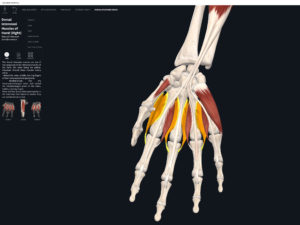Anatomy & Physiology: Muscles—Dorsal Interossei.
Structure.
- Origin: adjacent sides of metacarpals.
- Insertion: proximal phalanx of each finger.
Function.
- Concentric action: abduct fingers 2-4 at metacarpophalangeal joints; flex fingers 2-4 at metacarpophalangeal joints; and extends fingers at interphalangeal joints.
- Reverse mover action: abduct metacarpals of fingers 2-4; flex and adduct thumb at CMC; flex metacarpals of fingers 2-4 at MCP; extend proximal phalanges of fingers 2-4 at PIP and DIP.
- Eccentric action: controls/restrains/slows adduction, flexion and extension of fingers 2-4 at MCP.
- Isometric action: stabilize CMC of thumb, and MCP and IP for fingers 2-4.
- Innervation: ulnar nerve.
- Arterial supply: branches of radial and ulnar arteries.
Clinical Significance.
More.
- https://www.anatomynext.com/dorsal-interossei-of-hand/
- https://www.kenhub.com/en/library/anatomy/dorsal-interossei-muscles-of-the-hand
References
Biel, A. (2015). Trail guide to the body: A hands-on guide to locating muscles, bones and more.
Cedars-Sinai. (2018). Vertebrae of the spine. Retrieved from https://www.cedars-sinai.org/health-library/diseases-and-conditions/v/vertebrae-of-the-spine.html
Clark, M., Lucett, S., Sutton, B. G., & National Academy of Sports Medicine. (2014). NASM essentials of corrective exercise training. Burlington, MA: Jones & Bartlett Learning.
Jenkins, G., & Tortora, G. J. (2012). Anatomy and Physiology: From Science to Life, 3rd Edition International Stu. John Wiley & Sons.
Muscolino, J. E. (2017). The muscular system manual: The skeletal muscles of the human body.

